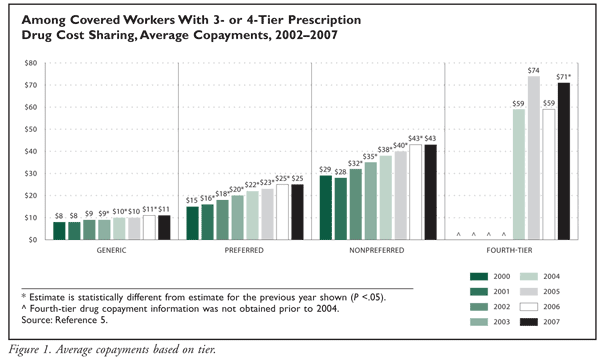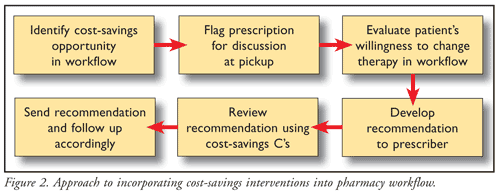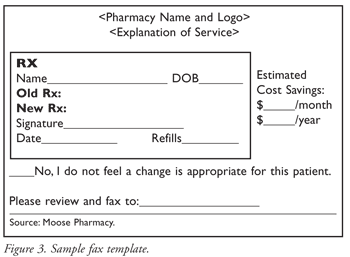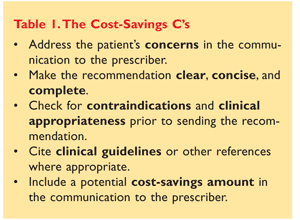US Pharm. 2010;35(6)(Generic Drug Review suppl):22-28.
Assessment of cost concerns is an important aspect of caring for a patient during a medication review. Medication cost has been identified as a contributor to medication-related problems and a barrier contributing to poor adherence.1-4 Pharmacists are uniquely qualified to identify and manage patient concerns regarding medication costs. Pharmacists’ accessibility and clinical knowledge allow them to safely and effectively recommend generic products as cost-effective therapeutic alternatives.
The implementation of Medicare Part D and rising drug costs have brought cost-efficacy management to the forefront of issues related to achieving quality patient care. Prescription drug spending in the United States is one of the fastest-growing components of national health care spending, jumping from $40.3 billion in 1990 to $216.7 billion in 2006.5 In response to rising drug costs, health plans have turned to stricter formulary management involving preauthorizations, excluded medications, quantity limits, and increases in copayments. This increased cost-sharing has placed a greater burden on patients and affects how well patients adhere to their medications.
Addressing Patients’ Cost Concerns
A quotation from former Surgeon General C. Everett Koop, MD, “Drugs don’t work in patients who don’t take them,” reinforces the importance of addressing patients’ cost concerns. Poor medication adherence results in 33% to 69% of all medication-related hospitalizations and has been associated with disease progression, death, and increased health care costs in the U.S.6-8 In contrast, increased medication adherence reduces medical costs and yields a net economic return despite increases in drug spending attributed to improved adherence.9 Cost often is not the patient’s sole medication-related concern; patients may be selective about which medications they take owing to side effects, safety or efficacy considerations, or degree of trust in their prescriber.2-4 Pharmacists in various practice settings are positioned to filter through and resolve these concerns, earning the loyalty and trust of their patients and preventing the serious consequences that result from poor adherence.
Patients may present with cost concerns independent of their third-party coverage. Patients without insurance are simply looking for ways to afford their medications; those with Medicare Part D plans are trying to lower their total drug costs and avoid the dreaded Medicare Part D coverage gap, often referred to as the “donut hole.” Patients with private insurance are worried that they may not be able to keep up with their copayments.
Some individuals will vocalize their concerns, whereas others may be reluctant to discuss the economic burdens they face. A nationwide survey of 660 patients with chronic illness revealed that two-thirds of respondents did not tell their prescriber that they intended not to take their medication because of the cost, and more than one-third did not discuss medication costs with the prescriber at all.10 Patients who did not tell their prescriber about their concerns said that either no one asked them or they did not think the prescriber could help. Finally, patients who did discuss cost with their prescriber found that, 31% of the time, their medication was not changed to a generic or more cost-effective alternative.10
How can the pharmacist ensure that patients’ concerns about medication costs are being addressed? Shawn Christopher Shea, MD, a leader in the field of clinical interviewing, suggests this tip for exploring cost issues: “Develop the habit of routinely asking every patient about the cost of his or her medications, because if you don’t ask, you often will not be told.”11
Pharmacists can identify patients with cost concerns by asking them about this issue on a regular basis. This can take place in a variety of practice settings, including the community pharmacy, the physician’s office, the ambulatory-care clinic, and the hospital. Pharmacists involved in discharge planning in an institutional setting can recognize cost concerns in their patients and potentially address high-cost medication issues before the patient is sent home. Cost issues can be identified during the medication-dispensing process, during a comprehensive or targeted medication therapy management (MTM) session, or during delivery of another clinical service. Incorporating a cost-sensitive approach into their practice allows pharmacists to lead the way in addressing patients’ medication-related concerns, improving medication adherence, and enhancing patient outcomes.
The Benefits of Using Generics
Generic alternatives are available for approximately 75% of FDA-approved medications.5 Unfortunately, despite pharmacists’ understanding of generic alternatives and their bioequivalence and therapeutic equivalence, patients often do not trust generics. There are several reasons for this. In a recent study funded by the Clinical Research Program of the American Diabetes Association, more than 800 low- and middle-income patients with diabetes were surveyed about their medication cost concerns.12 Thirty-one percent reported that they believe that generic medications are not as good as their brand-name equivalents, and 29% said that they believe that brand-name medications are safer. Also, 65% of patients agreed with the statement “Insurance companies push generics to save money at the expense of my health.”12 These numbers represent a significant opportunity for pharmacists to impart their knowledge about the therapeutic benefits a generic equivalent can have. The pharmacist can assure the patient that paying a higher price for a prescription medication does not necessarily mean a better outcome, especially if the patient is not taking the medication correctly on account of cost.
The financial benefit of utilizing generic medications is understood, but, in practice, pharmacists do not always take the time to put a value on these interventions. FIGURE 1, from the Kaiser Family Foundation, shows average copayments based on tier from 2000 to 2007.5 In 2007, the difference in cost between the average third-tier copayment and the generic copayment was $32. Based on these data, switching a patient from a third-tier or nonpreferred medication to a generic medication could result in an annual savings of more than $380.5

By looking at a patient’s copayment schedule and quickly calculating an annual savings, the pharmacist can quantify the benefit to the patient in his or her communication to the prescriber. Many times, this information is otherwise not available to the prescriber, which reinforces the value of the pharmacist in collaborating to provide patient care. Another way pharmacists can provide this information to prescribers is to report the savings in total drug costs when making generic recommendations for Medicare Part D patients. Switching from a brand-name proton pump inhibitor and statin to generic alternatives could save a Medicare patient more than $2,900 per year in total drug costs.13 These cost-savings amounts can be calculated from pharmacy claims information and drug pricing or from online resources such as Drugstore.com. Interventions like these not only save patients money up front on their copayments, but also may help them avoid the coverage gap.
There are also many benefits to the pharmacist for utilizing generics in cost-savings recommendations. Increased utilization rates of generics are financially beneficial to the pharmacy as a business. Generics require less overhead and often are reimbursed at a higher percentage by third-party payers. Less money is tied up in inventory, and a greater return on investment is achieved. Some retail pharmacies have generics initiatives, encouraging stores to meet specified percentages of generics utilization. Community CCRx, a Medicare Part D prescription drug plan provider with a focus on pharmacist involvement in patient care, has a generics dispensing-rate incentive program in which pharmacies receive an additional dispensing fee for each generic prescription dispensed.14
Medication Therapy Management
MTM programs recognize the importance of pharmacists in identifying and managing patients’ concerns regarding medication costs. Pharmacists are reimbursed for their time and efforts devoted to providing this service to patients who qualify. Depending on the MTM billing platform, the pharmacist may be able to seek reimbursement for the cost-savings recommendation, the discontinuation of the previous therapy, and the counseling on the new prescription. Time constraints associated with a hectic schedule often deter a pharmacist from pursuing these types of recommendations; however, incentives such as MTM fees, in addition to the other benefits mentioned, often mitigate the time spent on pursuing these recommendations. Finally, having auxiliary staff facilitate appropriate aspects of the recommendation process uses less pharmacist-paid time, thereby maximizing financial gain.
Incorporating Interventions Into the Pharmacy Workflow: Developing a systematic approach to incorporate MTM interventions into the pharmacy workflow is the first step (FIGURE 2). Joe Moose, PharmD, pharmacy owner and recognized MTM provider, offers this guidance: “Identifying poor medication adherence and cost-savings opportunities should be as routine as checking a prescription bottle for a safety versus a nonsafety cap.”15

First, it is important to determine how prescribers would like to receive this information. A faxed recommendation is often acceptable. Joe Moose and Whit Moose, Jr, fourth-generation pharmacists and owners of Moose Pharmacy, an independent, family-owned pharmacy in central North Carolina since 1882, have successfully worked with area physicians to help their patients better afford their medications through use of a fax template (FIGURE 3). A single-page template can be developed to ensure a uniform presentation. A brief statement outlining the service being provided to the patient may be made at the top of the template. The core of the template should be designed to highlight the previous prescription information and the generic alternative being recommended. Also important to incorporate into the template are a section for reporting the potential annual cost-savings amount and a means of responding, such as a fax number. The advantage of using a uniform template when making these recommendations is recognition; the prescriber begins to associate the template with the pharmacy. With a template prepared in advance, recommendations can be easily completed and forwarded to the prescriber as a regular component of the pharmacy workflow.

Identifying Patients With Potential Medication Cost Concerns: One approach is to target specific medications. Medication classes with generic therapeutic alternatives, such as statins, proton pump inhibitors, and selective serotonin reuptake inhibitors, are an easy place to start. Frequently, the more costly brand-name medications in these classes are used, providing for cost-savings opportunities. Dose conversions within these classes of medications are fairly straightforward. For example, statins have dose-dependent LDL reduction, and a generic alternative that provides the same percentage reduction can be recommended upon proper evaluation of a patient’s prescription and nonprescription medications. There are many dose-conversion resources available, including Facts & Comparisons, Lexi-Comp, and Pharmacist’s Letter.
Another approach to identifying patients with potential cost concerns is to flag prescriptions based on price during the dispensing process. This includes prescriptions for patients who are paying high copayments, patients who are uninsured and paying out-of-pocket, and Medicare Part D beneficiaries in the coverage. These prescriptions can be flagged during the dispensing process to prompt a conversation with the pharmacist at pickup.
Communicating With the Patient: It is important to initiate the conversation without judgment. Rather than pointing out high costs or poor adherence, the pharmacist can approach the subject by saying, “A medication is available that may provide you with the same benefits, but is less expensive. If you are interested, I can work with you and your doctor to make this change.” A semiprivate counseling area is important to ensure that the patient is comfortable, and it allows him or her to freely discuss any underlying medication-related problems.
Approaching the Prescriber: Upon identifying a patient’s cost concern and choosing an appropriate generic alternative, it is important to confirm that the patient has not tried this medication before. Reviewing the patient’s pharmacy profile, obtaining a medication history from the patient, and calling the prescriber’s office are all steps that can be taken to ensure that a therapy is not recommended that the patient failed in the past. Finally, the “cost-savings C’s” (TABLE 1) may be used to review recommendations for quality and completeness.

The cost-savings C’s can serve as a guide to applying quality cost-savings interventions. In highlighting the patient’s concerns and including an estimated cost-savings amount in the communication to the prescriber, the pharmacist often is providing the prescriber with information he or she does not have. This allows the pharmacist to collaborate with the physician, rather than being perceived as an infringement on the physician’s care of the patient. Utilizing evidence-based medicine to make recommendations and being aware of patient allergies, contraindications, and clinical considerations are all ways for pharmacists to assert their capabilities.
Conclusion
Educating patients about the financial benefits of generic medications, as well as enforcing their efficacy and safety, is a role that the pharmacist is best suited to fill. Pharmacists are accessible, knowledgeable, and qualified to manage patients’ cost-related medication concerns. Routinely assessing patients for cost concerns and effectively relaying this information to prescribers can lead to a variety of benefits, including financial incentives, strengthened relationships, improved medication adherence, and enhanced therapeutic outcomes.
REFERENCES
1. American Pharmacists Association, National Association of Chain Drug Stores Foundation. Medication therapy management in pharmacy practice: core elements of an MTM service model (version 2.0). J Am Pharm Assoc. 2008;48:341-353.
2. Piette JD. Cost-related medication underuse: a window into patients’ medication-related concerns. Diabetes Spectrum. 2009;22:77-80.
3. Goldman DP, Joyce GF, Zheng Y. Prescription drug cost sharing: associations with medication and medical utilization and spending and health. JAMA. 2007;298:61-69.
4. Gibson TB, Ozminkowski RJ, Goetzel RZ. The effects of prescription drug cost sharing: a review of the evidence. Am J Manag Care. 2005;11:730-740.
5. The Henry J. Kaiser Family Foundation. Prescription drug trends fact sheet—September 2008 update (#3057-07). www.kff.org/rxdrugs/upload/3057_07.pdf. Accessed January 9, 2010.
6. Osterberg L, Blaschke T. Adherence to medication. N Engl J Med. 2005;353:487-497.
7. McDonnell PJ, Jacobs MR. Hospital admissions resulting from preventable adverse drug reactions. Ann Pharmacother. 2002;36:1331-1336.
8. Senst BL, Achusim LE, Genest RP, et al. Practical approach to determining costs and frequency of adverse drug events in a health care network. Am J Health Syst Pharm. 2001;58:1126-1132.
9. Sokol MC, McGuigan KA, Verbrugge RR, Epstein RS. Impact of medication adherence on hospitalization risk and healthcare cost. Med Care. 2005;43:521-530.
10. Piette JD, Heisler M, Wagner TH. Cost-related medication underuse: do patients with chronic illnesses tell their doctors? Arch Intern Med. 2004;164:1749-1755.
11. Shea SC. Improving Medication Adherence: How to Talk With Patients About Their Medications. Philadelphia, PA: Lippincott Williams & Wilkins; 2006.
12. Aikens JE, Piette JD. Diabetes patients’ medication underuse, illness outcomes, and beliefs about antihyperglycemic and antihypertensive treatments. Diabetes Care. 2009;32:19-24.
13. Cost calculated from Drugstore.com pricing for Lipitor 20 mg ® simvastatin 40 mg and Nexium 40 mg ® omeprazole 20 mg on December 4, 2009.
14. MemberHealth. Pharmacy scorecard. https://reports.ccrxgroups.com. Accessed February 21, 2010.
15. Joe Moose, personal communication to the author.
To comment on this article, contact rdavidson@uspharmacist.com.






